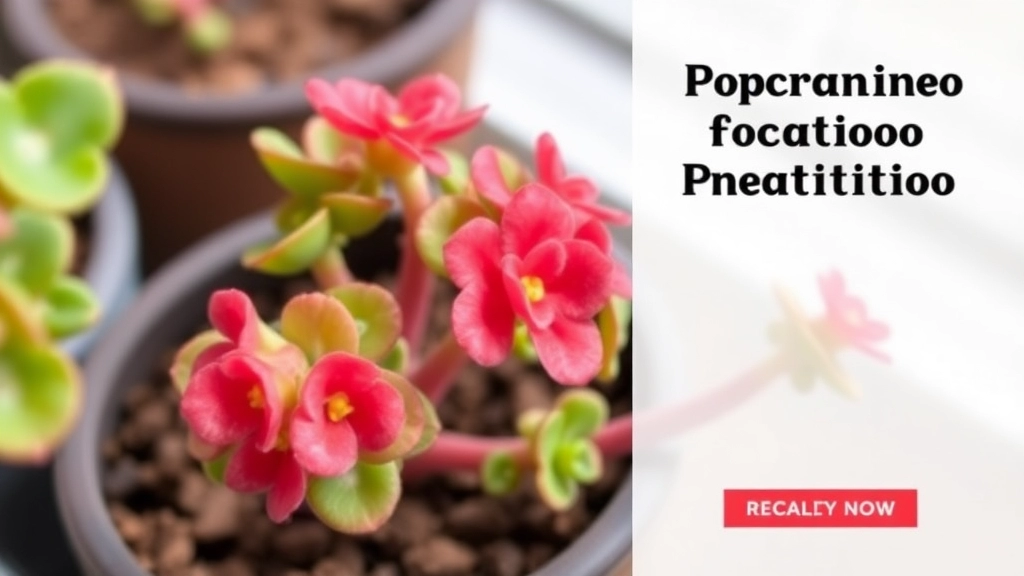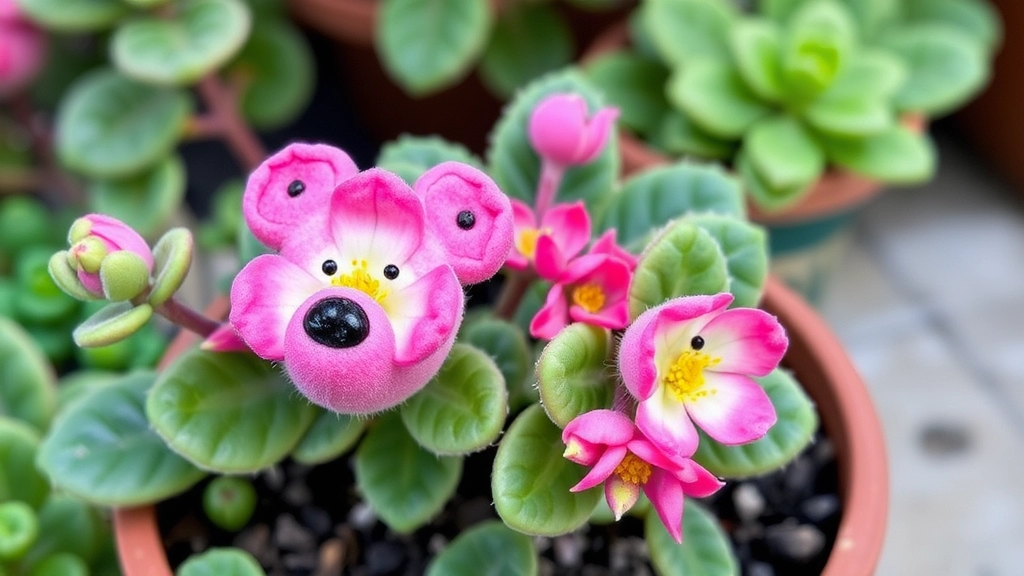Kalanchoe Tomentosa ‘Teddy Bear’
If you’re looking to add a touch of whimsy to your indoor or outdoor garden, the Kalanchoe Tomentosa ‘Teddy Bear’ is a fantastic choice. This charming succulent, with its fuzzy, teddy bear-like leaves, thrives in various lighting conditions, making it a versatile addition to any plant collection.
Care Instructions
To keep your Kalanchoe Tomentosa ‘Teddy Bear’ healthy, it’s crucial to understand its soil and watering needs. Opt for well-draining soil and be mindful not to overwater, as this can lead to root rot. With the right care, this delightful plant will flourish, adding a unique aesthetic to your space.
When it comes to caring for your Kalanchoe Tomentosa ‘Teddy Bear’, one of the first questions that might pop into your mind is: How much light does this charming succulent really need?
This delightful plant thrives best in bright, indirect sunlight.
– **Direct Sunlight**: While it can tolerate some direct sunlight, too much can scorch its leaves.
– **Optimal Positioning**: A south-facing window is ideal, providing ample light without the harshness of midday rays.
– **Signs of Insufficient Light**: If your plant starts to stretch or become leggy, it’s a clear sign it’s not getting enough light.
– **Seasonal Changes**: During the winter months, you might need to adjust its location to ensure it receives adequate light.
For more detailed care instructions, check out our [comprehensive Kalanchoe plant care guide](https://planthq.org/comprehensive-kalanchoe-plant-care-guide/). If you’re interested in purchasing a Kalanchoe Tomentosa, visit our [online store for the best prices and quality](https://planthq.org/buy-kalanchoe-tomentosa-online-best-prices-quality/).
Soil and Watering Needs

So, you’re all set to give your Kalanchoe Tomentosa ‘Teddy Bear’ the best care possible. But have you thought about its soil and watering needs?
Soil Requirements
This little succulent thrives in well-draining soil.
- Cactus Mix: A pre-made cactus or succulent mix works wonders.
- DIY Option: You can mix regular potting soil with sand or perlite for that extra drainage.
The key here is to avoid waterlogged roots. These plants are not fans of sitting in soggy soil.
Watering Tips
Now, let’s talk about watering. When it comes to Kalanchoe Tomentosa, less is more.
- Frequency: Water every 2-3 weeks during the growing season (spring and summer).
- Check the Soil: Always stick your finger in the soil. If the top inch feels dry, it’s time to water.
- Seasonal Adjustments: In the winter, cut back on watering to once a month or even less.
Remember, the goal is to keep the soil slightly moist but never drenched.
Fertilizing Schedule for Kalanchoe Tomentosa ‘Teddy Bear’
When it comes to nurturing your Kalanchoe Tomentosa ‘Teddy Bear’, many plant enthusiasts often wonder about the best fertilizing schedule.
A well-timed fertilization routine can significantly enhance the growth and health of your succulent.
Key Points to Consider:
- Frequency: Generally, fertilising every 4-6 weeks during the growing season (spring and summer) is ideal. This keeps your plant nourished without overwhelming it.
- Type of Fertilizer: Opt for a balanced, water-soluble fertilizer with a ratio like 10-10-10 or a cactus-specific formula. These provide the necessary nutrients without excess nitrogen, which can lead to leggy growth.
- Dilution: Always dilute the fertilizer to half the recommended strength. This prevents root burn and ensures your Kalanchoe receives nutrients gradually.
- Application Method: Water your plant lightly before applying the fertilizer. This helps the roots absorb nutrients more effectively.
- Seasonal Adjustment: In the fall and winter, reduce or eliminate fertilizing. Your plant enters a dormant phase, requiring less nutrition.
By following this fertilizing schedule, your Kalanchoe Tomentosa ‘Teddy Bear’ will thrive and produce its characteristic fuzzy leaves. For more detailed care instructions, check out our complete guide to caring for Kalanchoe Tomentosa. Additionally, if you’re interested in learning about different varieties, visit our guide on Kalanchoe Tomentosa varieties.
Temperature and Humidity Tolerance

When caring for Kalanchoe Tomentosa ‘Teddy Bear’, understanding its temperature and humidity preferences is essential for promoting healthy growth.
Ideal Temperature Range:
- Kalanchoe ‘Teddy Bear’ thrives in temperatures between 20°C to 25°C (68°F to 77°F).
- It can tolerate slightly cooler temperatures down to 10°C (50°F) but should be protected from frost.
Humidity Levels:
- This succulent prefers low to moderate humidity levels.
- Aim for a humidity range of 30% to 50% to keep your plant happy.
Tips for Temperature and Humidity Management:
- Avoid drafts: Keep your plant away from cold drafts or hot air vents.
- Indoor placement: If indoors, a south-facing window is ideal, providing warmth and light.
- Outdoor care: If placed outside, ensure it’s sheltered from extreme weather changes.
When considering the size and growth patterns of Kalanchoe Tomentosa ‘Teddy Bear’, you might wonder how to best accommodate this charming succulent in your space.
Kalanchoe Tomentosa ‘Teddy Bear’ typically grows to a height of about 30 to 45 cm (12 to 18 inches) and can spread similarly.
Growth Characteristics:
– **Growth Rate:** Moderate; expect steady growth during the warmer months.
– **Form:** Bushy and compact, making it an excellent choice for small spaces.
– **Leaves:** Thick, fuzzy leaves are adorned with distinctive brown edges, adding a unique texture to your collection.
Factors Influencing Growth:
– **Light Exposure:** Adequate light prompts more robust growth.
– **Watering Practices:** Overwatering can stunt growth, while under-watering can lead to shrivelling.
– **Pot Size:** A larger pot can encourage more expansive growth, while a smaller pot may restrict it.
As a succulent, its growth is also influenced by dormancy periods, typically in winter, where growth slows down significantly.
In terms of maintenance, pruning can encourage a bushier appearance and prevent leggy growth. For more detailed guidance, check out this [complete guide to Kalanchoe Tomentosa care](https://planthq.org/how-to-care-for-kalanchoe-tomentosa-complete-guide-2/) and learn about the [best watering practices for Kalanchoe Tomentosa](https://planthq.org/kalanchoe-tomentosa-watering-best-practices-tips/).
Propagation Techniques for Kalanchoe Tomentosa ‘Teddy Bear’

So, you’re loving your Kalanchoe Tomentosa ‘Teddy Bear’ and thinking about spreading the joy?
Propagation is a fantastic way to expand your collection or share with friends.
Leaf Cuttings
- Choose Healthy Leaves: Pick a few plump, healthy leaves from your plant.
- Let Them Callous: Place the leaves on a dry surface for a couple of days. This helps prevent rot when you plant them.
- Plant Them: Once calloused, lay them on top of well-draining soil and lightly press down. Don’t bury them!
- Water Sparingly: Give them a light misting, but avoid soaking. Keep the soil just barely moist.
Stem Cuttings
- Select a Stem: Cut a healthy stem, around 4-6 inches long.
- Remove Lower Leaves: Trim off the leaves from the bottom half to prevent rot.
- Callous Time: Just like with leaves, let the cut end dry for a day or two.
- Plant and Water: Stick the cut end into well-draining soil, then give it a light watering.
Offsets
- Look for Offsets: These are little baby plants that grow around the base.
- Gently Remove: Use a clean knife to cut them away from the main plant, ensuring you get some roots.
- Replant: Pop them into their own pots with the right soil mix and water lightly.
Tips for Success
- Bright Indirect Light: Keep your cuttings in a spot with plenty of bright, indirect sunlight.
- Humidity: A little humidity can help, so consider covering them with a plastic bag for a few days—just remember to lift it occasionally for air circulation.
- Patience is Key: It might take a few weeks for roots to develop, so hang tight!
Propagation can be a rewarding experience, and before you know it, you’ll have a mini jungle of ‘Teddy Bear’ plants.
Common Pests and Diseases
As we delve into the care of Kalanchoe Tomentosa ‘Teddy Bear’, it’s crucial to address potential challenges, particularly pests and diseases that may hinder its health.
What Pests Should You Watch For?
Kalanchoe Tomentosa can attract a few common pests:
- Mealybugs: These small, white, cotton-like insects often cluster in leaf joints. They can cause yellowing and wilting.
- Spider Mites: Tiny and often unnoticed, these pests can create webbing and lead to leaf drop.
- Aphids: These small green insects can distort new growth and spread diseases.
Identifying Diseases
In addition to pests, your plant may face diseases such as:
- Powdery Mildew: A white, powdery fungus that can develop in high humidity. It can inhibit growth and affect overall health.
- Root Rot: Often caused by overwatering, this disease leads to mushy roots and can be fatal if not addressed promptly.
How to Combat These Issues
- Regular Inspections: Check your plant weekly for any signs of pests or disease.
- Natural Remedies: Use insecticidal soap or neem oil to treat infestations.
- Proper Watering: Ensure your Kalanchoe is not sitting in water to prevent root rot.
By staying vigilant and addressing any issues early, you can keep your Kalanchoe Tomentosa healthy and thriving. For more detailed tips, you might want to explore the complete guide for thriving Kalanchoe Brasiliensis or learn about healthy growth tips for Kalanchoe Synsepala.
Creative Design and Landscaping Ideas for Kalanchoe Tomentosa ‘Teddy Bear’

So, you’ve got your Kalanchoe Tomentosa ‘Teddy Bear’ thriving, and now you’re wondering how to showcase it in your space?
Let’s dive into some creative design and landscaping ideas that will make your little succulent shine.
1. Container Gardens
- Use quirky pots or terrariums to create a focal point.
- Mix with other succulents for a vibrant display.
- Choose containers that match your home’s decor—rustic, modern, or eclectic.
2. Rock Gardens
- Pair ‘Teddy Bear’ with stones and gravel for a natural look.
- Create elevation by placing them on rocks or raised beds.
- This combo not only looks great but also mimics their natural habitat.
3. Vertical Gardens
- Consider wall-mounted planters for a unique touch.
- Use shelves or hanging planters to save space and add height.
- This can be a fun way to showcase multiple plants without taking up too much ground space.
4. Indoor Displays
- Place them on windowsills where they can soak up the sun.
- Group them with other houseplants for a lush feel.
- Use decorative trays to catch any water runoff and keep things tidy.
5. Outdoor Spaces
- Perfect for patios or balconies—just ensure they get enough light.
- Create a mini succulent garden with varied textures and colours.
- Add some fairy lights for a magical evening vibe.
6. Themed Arrangements
- Think seasonal! Decorate for holidays with themed accessories.
- Use cute figurines or stones to add character to your arrangement.
- This can be a fun project to do with friends or family.
Remember, the key is to let your creativity flow while keeping the plant’s needs in mind.
Troubleshooting Common Care Problems for Kalanchoe Tomentosa ‘Teddy Bear’
As we delve deeper into the care of Kalanchoe Tomentosa ‘Teddy Bear’, it’s essential to address the common challenges that can arise.
Identifying Common Issues
Many enthusiasts often find themselves facing issues with their plants. Here are some common concerns:
- Leaf Drop: If your plant is shedding leaves, it may be due to overwatering or insufficient light.
- Leggy Growth: This often indicates that your Kalanchoe isn’t receiving enough sunlight.
- Pest Infestations: Look out for signs of mealybugs or aphids, which can compromise your plant’s health.
Solutions to Common Problems
1. Leaf Drop
- Check Watering: Ensure the soil is dry before watering again.
- Adjust Light: Move the plant to a brighter location.
2. Leggy Growth
- Increase Light Exposure: Position your plant in a sunnier spot to encourage compact growth.
3. Pest Infestations
- Inspect Regularly: Routinely check for pests.
- Use Insecticidal Soap: Treat infestations promptly with a safe pesticide.
Maintaining Plant Health
Regular monitoring is key to preventing these issues.
- Adjust Care: Be flexible with light, water, and feeding based on seasonal changes.
- Observe Plant Responses: Learn to read your plant’s signals; they often tell you what they need.
For more detailed care tips, you can check out our Kalanchoe Chocolate Soldier Care Guide or explore our Ultimate Guide to Caring for Kalanchoe Flaming Katy.
FAQs for Kalanchoe Tomentosa ‘Teddy Bear’
What type of soil is best for Kalanchoe Tomentosa ‘Teddy Bear’?
The best soil for Kalanchoe Tomentosa ‘Teddy Bear’ is well-draining soil. A pre-made cactus or succulent mix works well, or you can create your own by mixing regular potting soil with sand or perlite.
How often should I water my Kalanchoe Tomentosa ‘Teddy Bear’?
Water your Kalanchoe Tomentosa every 2-3 weeks during the growing season (spring and summer). In the winter, reduce watering to once a month or even less. Always check the soil first; if the top inch feels dry, it’s time to water.
What temperature range is ideal for Kalanchoe Tomentosa ‘Teddy Bear’?
Kalanchoe Tomentosa ‘Teddy Bear’ thrives in temperatures between 20°C to 25°C (68°F to 77°F). It can tolerate slightly cooler temperatures down to 10°C (50°F) but should be protected from frost.
What humidity levels are suitable for Kalanchoe Tomentosa ‘Teddy Bear’?
This succulent prefers low to moderate humidity levels, ideally between 30% to 50%.
How can I propagate my Kalanchoe Tomentosa ‘Teddy Bear’?
You can propagate your Kalanchoe Tomentosa ‘Teddy Bear’ using leaf cuttings, stem cuttings, or offsets. Ensure the cuttings callous before planting them in well-draining soil and water sparingly.
What are some creative ways to display my Kalanchoe Tomentosa ‘Teddy Bear’?
Here are some creative ideas:
- Container Gardens: Use quirky pots or terrariums.
- Rock Gardens: Pair with stones and gravel.
- Vertical Gardens: Use wall-mounted planters or shelves.
- Indoor Displays: Place on windowsills or group with other houseplants.
- Outdoor Spaces: Perfect for patios or balconies.
- Themed Arrangements: Decorate for holidays or use figurines.
What are some tips for managing temperature and humidity for Kalanchoe Tomentosa ‘Teddy Bear’?
To manage temperature and humidity:
- Avoid drafts: Keep your plant away from cold drafts or hot air vents.
- Indoor placement: A south-facing window is ideal for warmth and light.
- Outdoor care: Ensure it’s sheltered from extreme weather changes.
What should I avoid when caring for Kalanchoe Tomentosa ‘Teddy Bear’?
Avoid overwatering and waterlogged roots. Ensure the soil is well-draining and never let the plant sit in soggy soil. Also, protect the plant from frost and extreme temperature changes.
How long does it take for Kalanchoe Tomentosa ‘Teddy Bear’ cuttings to root?
It might take a few weeks for roots to develop. Be patient and ensure the cuttings are kept in bright, indirect light and slightly moist soil.
References
-
The Spruce: Growing Kalanchoe Tomentosa
-
World of Succulents: Kalanchoe Tomentosa (Panda Plant)
-
Succulent City: Kalanchoe Tomentosa Care Guide
